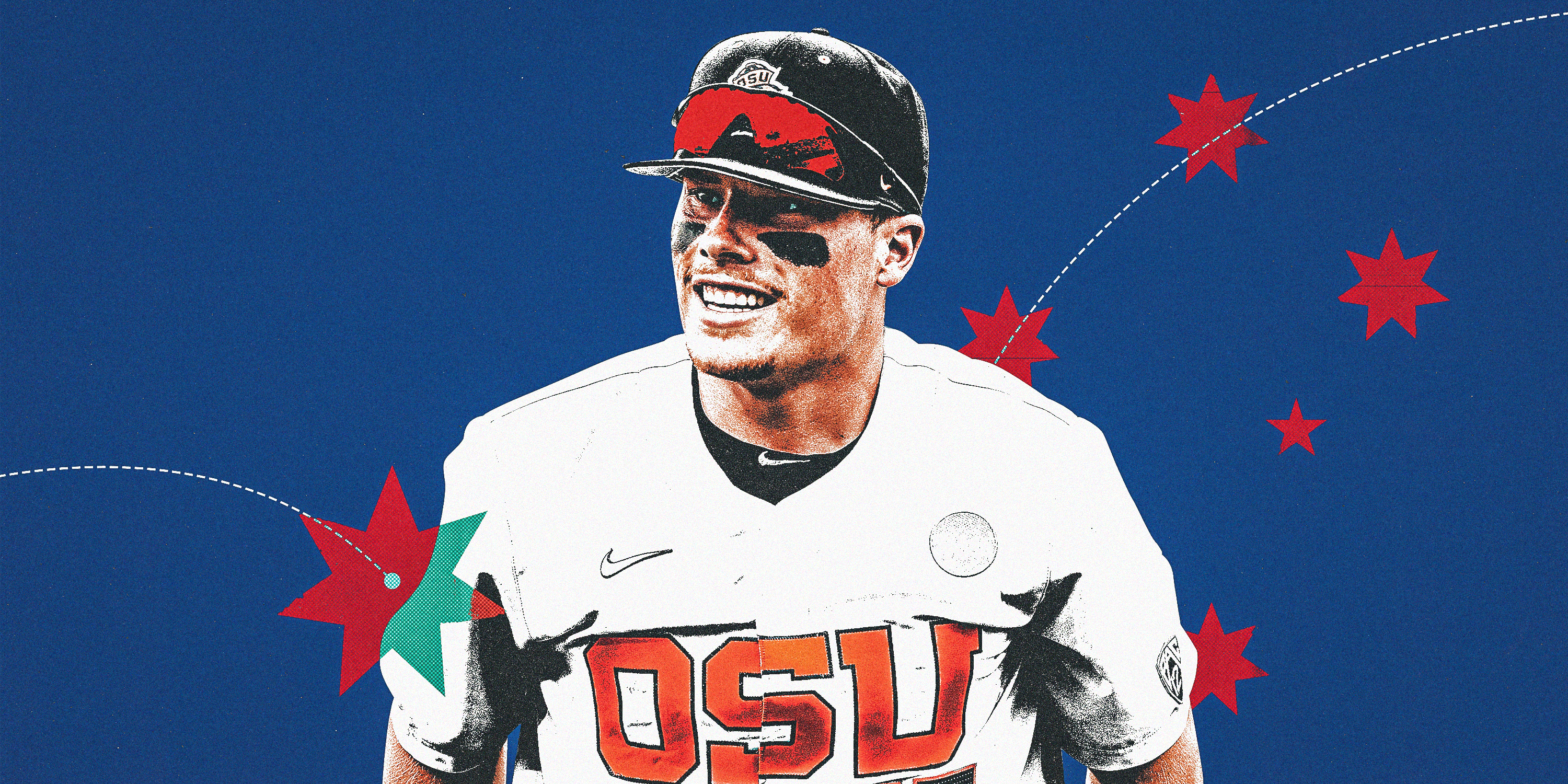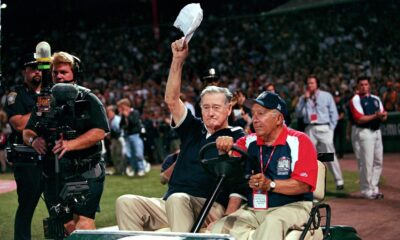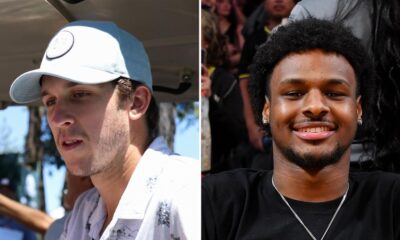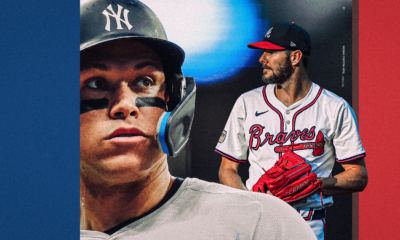Sports
He’s an Aussie schooled in cricket. And he might be the top pick in the 2024 MLB Draft

CORVALLIS, Ore. — In 1884, less than three decades after American miners introduced the sport to a new continent during the Victorian gold rush, an Australian made his professional baseball debut. Joe Quinn, born in a squatters’ camp outside of Ipswich, Queensland, years before his family immigrated to Iowa, suited up for the St. Louis Maroons of the United Association. Inauspiciously, the league folded after his first year. But it merged with the then-fledgling National League and Quinn appeared in 1,772 games for seven teams. One year, as a player-manager, he led the Cleveland Spiders to a total of 12 wins. He worked as a mortician in the offseason. He played his last game in the summer of 1901.
It would be 85 years before another Aussie set foot on a major-league diamond in the United States.
But a line that continued when Craig Shipley broke through with the Los Angeles Dodgers in 1986 now stretches 38 men long. Three Australians have made major league All-Star teams. It is not a robust history comparable to, say, the Dominican Republic or Japan. But it’s something.
So it’s a little weird that nobody in the land of the “fair go” – an Australian ethos that, in part, emphasizes opportunity for all – assured Travis Bazzana he could do what nobody else has done.
“Why are there 1,000 kids in America that can go to these schools every year for baseball and I couldn’t do that?” says Bazzana, one of college baseball’s best hitters, sitting at a mezzanine picnic table inside Oregon State’s Goss Stadium this spring. “Because I’m from Australia? It doesn’t make sense. If I work towards being ready for that as a player, then it shouldn’t matter that I’m from Australia, and ‘Australians don’t do that.’”
On Sunday, Travis Bazzana will be the first Australian-born player selected in the first round of the Major League Baseball draft. If the consensus All-American second baseman doesn’t go No. 1 overall to the Cleveland Guardians, he likely won’t slip out of the top 5. A prospect who filled developmental gaps by playing cricket takes a massive step in changing a national paradigm. It’s a lot to process, for everyone else.
During his college recruiting visit, Bazzana took photos of the records on display in Oregon State’s recruiting lounge, to note the bars to surpass. He gave a presentation on induced vertical break and slider usage after studying them during the summer of 2022. He wears a nasal strip and tapes his mouth shut to maximize sleep and recovery. He envisions not only Olympic medals, but also the necessary infrastructure to earn them.
What’s next is not a mystery but a decision. Because he’s thought of everything. “I’m going to look for edges in all aspects of life, knowing it’s not just the five tools or going out here between the lines,” Bazzana says. “There’s so much more that goes into it. And I’m looking to be the best at those things. My ‘why’ leads to me caring a lot about being great at this. And being great is more than just doing what everyone else does.”
Once upon a time, a friend of Gary Bazzana’s asked Gary to join a local baseball team. Gary did and loved it. Years later, he introduced the sport to his three sons. The youngest was especially enthralled. “It was my identity from when I was pretty young,” Travis Bazzana says. He guesses he was 7 or 8 when he started logging on to MLB.com every day after school to study highlights of the day’s home runs, trying to understand what those swings looked like and how to recreate them. At age 10, his coach sent videos to officials in Williamsport, Pa., to prove Travis was worthy of an exemption to play up for a team seeking the country’s Little League World Series berth. At 15, he linked up with the Sydney Blue Sox of the Australian Baseball League, the country’s top level of pro baseball. Bazzana hit a respectable .257 across three seasons competing against players twice his age.
He was the baseball kid, per local shorthand, in a country without many of them.
Eventually, videos and word of mouth about his makeup from people such as former major league pitcher and Australian Ryan Rowland-Smith made their way up the banks of the Willamette River. The Oregon State staff caught Bazzana during a showcase in Arizona in 2018 and offered a scholarship when Bazzana kited into town for that recruiting visit. And by the end of it all, Bazzana had set eight Oregon State career records, capped by a junior campaign in which he hit .407 and established new single-season standards for homers (28), runs (84), walks (76), total bases (195) and slugging percentage (.911).
Unprecedented. Unstoppable. Unbelievable. Australian. 🇦🇺
Sydney’s Travis Bazzana hit 2 homers today, setting the all-time Oregon State runs scored record.
He had 5 RBI today, 4 homers his last 2 games and 10 hits his last 3.
He could go 1st in the MLB draft. pic.twitter.com/sOm6rJIAkh
— Team Australia (@TeamAusBaseball) March 20, 2024
He’s played cricket and rugby and comes from the other side of the world. But this is a baseball story, not a bedtime story. “It’s always good when Australians can break some new ground,” says Liam Hendriks, the Boston Red Sox veteran righty and Perth native, who is one of the trio of Aussies to make an All-Star team. “Even being in the conversation (for No. 1 overall) will be great for Australian baseball.”
The trajectory makes sense – college program finds supremely gifted prospect overseas, said prospect delivers, professional franchise drafts him – but if it happened all the time for Australians, it would’ve happened already.
Bazzana is the outlier, because more has never been too much. “A lot of kids, no matter where they’re from, don’t have as clear of a picture of their goals that Bazz had,” Oregon State assistant coach Ryan Gipson says.
It was good fortune that Golden Jubilee Field, a park in the Sydney suburb of North Wahroonga, had batting cages and a pitching machine and was less than a 10-minute drive from home. A resource not widely available in Australia was available to Bazzana for hours and hours at a time … but that also required recognition of what being there for hours and hours, with his father feeding ball after ball into the machine, could do for him. “If I was struggling to hit the inside pitch, we’d do inside pitch,” Bazzana says, “and I’d get blown up in the cold night with a wood bat, over and over, until I could figure it out.” It allowed him to pile up repetitions, but not at the pace of peers in, say, the United States, where players might compete in three times as many games.
Fortunately, there was also cricket.
Another sport where a wood implement has to meet a small object moving with velocity and spin. And a heaping dose of urgency to connect: Record an out as a batsman, and you’re done for the entire match, left to stew on failure for hours. No surprise that Bazzana reluctantly recalls a game for the St. Ives Cricket Club in which he recorded a “golden duck” – cricket slang for scoring zero runs on the very first bowl. “You have to be able to lock in perfectly and have a plan for every ball,” he says now. “If you mess up, you’re done.”
The correlation is not accidental. “The hundreds of thousands of reps of more hand-eye coordination is directly applicable to being a great hitter in baseball,” says Oregon State assistant coach Joey Wong, who played overseas in Australia. “It’s really helped him become an elite manager of the strike zone. Being able to recognize pitches and where they start, where they’re going to end up. He’s become probably the best in the country at swing decisions.”
Bazzana was no remedial hitter when he set foot in a new country – he hit .429 with an OPS of 1.064 in 45 games with the Corvallis Knights of the collegiate West Coast League the summer before his freshman season – but neither was he fully formed in the box. “He hadn’t even learned to hit homers yet,” Oregon State head coach Mitch Canham says. (Bazzana hit one in 189 at-bats in that stretch.) Resources, though, would no longer be a problem at a program with 26 conference championships and three College World Series titles. And a glut of information and technology fed a baseball brain like a firehose filling a balloon that never pops.
Bazzana slugged .478 as a freshman and struck out 62 times in 302 plate appearances – neither a satisfactory figure – and then dove into 10 weeks of swing work and data analysis via motion capture and other tools at a Driveline Baseball facility in Seattle. He added 5 miles per hour to his bat speed, per Driveline, and created a flatter swing plane to better match pitches in the zone. The dingers went up (11 as a sophomore, 28 as a junior) and the whiffs went down (47 as a sophomore, 37 as a junior). “I think he actually keeps notes in his phone of how many times he chases out of the zone,” says Oregon State outfielder Micah McDowell, one of Bazzana’s roommates. “That day-to-day process with him is unbelievable, when a lot of guys get gooned out looking at that stuff.”
Canham describes Bazzana as “a walking TrackMan,” referencing the widely used program that measures ball trajectory, spin rates, release points and more. During a series at Washington State late in the 2024 season, Bazzana shook the weight off his bat in the on-deck circle and turned to the Oregon State dugout for a reminder. “Hey, what’s the horizontal break on his slider?” he yelled. There was a brief pause for incredulousness – the Beavers’ best hitter wanted that information now? – before someone barked out, “Fourteen!”
Bazzana shook his head and made his way to the box.
It’s not data. Not anymore. As Canham puts it, it’s his former star’s language. “I go up there with a clear, confident mind,” Bazzana says, “and a plan to battle that pitcher, whoever it is, every single time.” The capacity to process information with remarkable fluency has created what those around him consider to be Bazzana’s separating factor as a hitter: an ability to make swing adjustments in the sliver of time between pitches.
“Some guys it’s weekend-to-weekend or game-to-game,” Canham says. “I always thought the good ones are at-bat-to-at-bat, getting back in it. But he’s very much so pitch-to-pitch. He’s always going to hit.”
Meanwhile, the consumption became all-consuming. Anyone in Bazzana’s orbit felt the pull of his research, insights and innovations. “The running joke is, if you’re his roommate, your OPS is going to go up 200 points,” Gipson says. It was after that summer at Driveline that Bazzana made the PowerPoint presentation on induced vertical break to the rest of the Oregon State squad. During workouts, Bazzana would catch sight of pitchers working in the bullpen and drift off to discuss what he sees. In-depth discussions about pitch shape or usage or defensive alignments behind the mound were basically a weekly occurrence, at least, per Oregon State starter Aiden May. “There are a lot of talented guys, there’s a lot of focused guys, there’s a lot of people who are very naturally skilled,” May says. “But not a lot of guys who are that can affect the rest of the people around them quite like Travis can.”
There was also Bazzana’s pursuit of a cold tub to install in the garage of his off-campus residence – rendered moot when Oregon State added one to its facility. Or the steaks and fish he’ll prepare for himself and his roommates, in alignment with best nutritional practices. Or the presentation he delivered to the team last fall entitled “Champion Habits,” focused on sleep and recovery and general discipline. Hence the nasal strip and taped-shut mouth and white noise machine in bed at night … and why McDowell, his roommate, picked up the practices. “It’s super contagious,” McDowell says. “I’ve never played with anyone in any sport that just is so driven and is constantly thinking about how to better himself.”
When Bazzana arrived at Oregon State, fully invested in creating the best opportunity to reach the majors, he thought kinesiology would be a worthy major. Learn about the body and how and why it moves like it does, and all that. Then he discovered he’d be sidetracked by requirements such as a chemistry course he had no use for, so he made another adjustment. He chose psychology. Learning about the brain and relationships and people, he figured, would bring out more in himself and everyone around him.
There have been no false steps to this coming Sunday, which is remarkable given how long the path has been. But then there’s only ever been one thought behind every one of those steps.
“Someone’s gotta be the best,” Bazzana says. “Why are they the best? And how can I do that?”
Travis Bazzana’s capacity to process information has created what many consider to be his separating factor as a hitter: an ability to make swing adjustments between pitches. (Jeff Moreland / Icon Sportswire via Getty Images)
In five World Baseball Classics, Australia has won five games. Its last run was a minor breakthrough: three victories and a quarterfinal appearance in 2023. It took home an Olympic silver medal two decades ago – the only time Australia left the Summer Games with a winning record – and then failed to qualify for the next two before the sport was entirely removed from the event slate.
A country that takes up 5.2 percent of the earth’s landmass is, in this specific context, not overly noticeable.
The best baseball prospect Australia has produced thinks about everything, but maybe the future of the game in his home country most deeply. Bazzana envisions medaling in international competitions to confirm Australia’s place as a power in the sport. On a smaller scale, it’s spearheading efforts to improve the training environments and coaching to bring them up to standard, so those who want the resources will have them. He doesn’t know exactly how it will work, being in the United States and affecting change 16 hours away. He just says he’ll find a way to figure it out.
But the want-to is not as powerful without credibility behind it. That’s the meaning of Sunday, whenever his name is called.
Travis Bazzana, the baseball kid from Australia, will be one of the first of more than 600 prospects selected by major league franchises. It could be anyone else in the world, and it’s one of their own. And what comes next could be anything.
“At the stem of it,” Bazzana says, “it’s belief.”
— The Athletic’s Andrew Baggarly contributed to this report.
(Illustration: Dan Goldfarb / The Athletic; photo: Jeff Moreland / Icon Sportswire via Getty Images)









